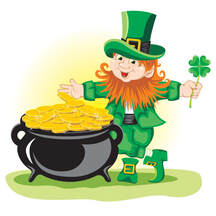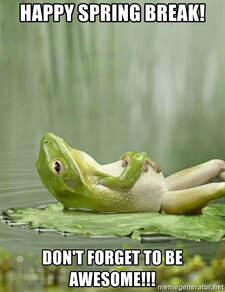 Last week as we were talking about St. Patrick's day, it was let slip that the intermediate teachers had been complaining about mysterious messes happening in their classrooms overnight. And as we had read a book about a cheeky leprechaun the day before, Team Awesome was already aware that it was the time of year a little trickster might visit. It wasn't long before someone mentioned catching our tiny visitor and you know Team Awesome- they wanted a piece of that action pronto! Which led to a flurry of activity later that morning as the children first planned then built their own traps to catch the little man. If you picked up your child at the end of the day you might have heard about the traps placed willy-nilly around the class, looking mostly like pieces of recycling that hadn't been picked up but boy did a lot of thought and effort go into them. If we didn't catch the leprechaun that evening we would have to revisit and revise our traps as many of them didn't actually have doors that closed. So while a few traps had some bait in the form of shiny things to lure the fairy creature inside, there was nothing to keep the leprechaun in the trap after he stole the bait and had a nap. And that's what scientists do- revisit and revise ideas if they don't work the first time! As the children entered our learning spaces the next morning they noticed a wee bit of untidiness- books and blocks spilled, papers on the floor, pencils left about and things turned upside down. There were squeals of delight and excitement as the children checked their leprechaun traps and discovered multi-coloured glitter (and a tiny potato!) around their traps and our classroom. But alas, no leprechauns. As we looked around we discovered the smarty pants had left a note and little green handprints everywhere. And of course, very big messes, which the children worked together to tidy. We resolved to catch him that night. To that end, we shared how our traps were supposed to work, why we thought they didn't, and how we could improve them and that afternoon some of us spent some time upgrading our designs while others had had enough of the sneaky little guy and played with centres. A few of us made totally new traps. Bigger and better traps. And a few of us tried to be sneakier when setting them up- we put them in places the unsuspecting leprechaun was sure to go based on where he went the previous night or we tried to camouflage them. Our fingers were crossed that we would be luckier that evening than we were the night before. Well, that sneaky little leprechaun foiled us again despite our cleverly hidden(?) traps. And not only that, but he also felt the need to leave shiny shamrocks in our traps and green and gold clovers all over our room and have a bubble bath in our sink (and leave unmentionables in our toilet). If I didn't know better I would say our resident compact green guy invited his friends and they had a big party and forgot to clean up afterwards. We were excited to find he left us a nifty poem stating that he won't be returning (Boo!) and part of his pot of gold (Yay!). Team Awesome was glad he came to visit us but sad to learn he wouldn't be sticking around. We talked about setting up our traps at home in the hopes that we might catch a leprechaun there. If you did happen to catch one, don't forget they disappear in the blink of an eye- and please don't give him directions to our classroom. One leprechaun party a year is quite enough. ** We have so many pictures and videos around these activities that it was impossible to make them into a video to show you the fun we had. Please look at the March photo album in Google to see them and share in a bit of the magic.
Team Awesome has been learning about measuring and comparing using nonstandard units such as these paper clips. Measuring with non-standard units means measuring things with blocks, pencils, hands, feet, etc rather than rulers and tape measures. As long as the items used to measure with are all the same size, e.g. identical blocks or brand new pencils, they are suitable. Measurement builds number sense by having students make predictions and then allowing them to use measurement to check their prediction. Team Awesome is being provided lots of opportunities to sort objects by size using everyday activities and experimenting with real objects. Words such as measure, taller than, shorter than, wider than, narrower than, length, volume, weight, area, centimeter, meter, heavier and lighter are all vocabulary words that the children are introduced to and use during our various measurement activities. Seriously, have you ever met a kid that wasn’t intrigued with how big or small something is? Its exploration at it’s best and when we can add in numbers and counting . . . bonus.
As part of our health and nutrition unit, we learned about brushing our teeth as a way to take care of ourselves this past week. Of course, this is a subject that Team Awesome is familiar with and they had a lot to contribute on the subject. We read some books, learned about bacteria in our mouth and plaque and did a few experiments to bring home how important brushing and flossing our teeth regularly really is. Oh- and we listened to this song a number of times, but beware, it gets stuck in your head and will pop up at the most inopportune times and you just can't help but sing the chorus out loud. Crawford The Cat gave us a few pointers and we learned how toothpaste and tooth brushes are made as well. We hope that seeing why brushing is so important will help lessen the nightly arguments over taking care of our teeth.
Have you checked out the new Kamloops Spring and Summer activity guide? Take a look at it here and begin planning all the family's new fun activities!
Young children are inherent measurers and this is reflected strongly in everyday language when they compare, order and match – I can swim right across the pool now; it’s too big for me to lift; it won’t fit in the box; my hand is bigger than your hand. Personal experiences, such as playing with toys, interactions with other children and conversations with parents all reinforce children’s early development of the concept of attributes that can be measured. Students need experiences that lead to an understanding of why measurement is necessary and helpful. They need to work with non-standard units and to create their own measuring instruments, and to discover for themselves the necessity of having standard units and the efficiency of having measuring instruments to count the units. Team Awesome has been exploring length through hands-on activities with these objectives in mind and will also play with the concepts of weight, area and capacity. What fun!
 For some of us, books are as important as almost anything else on earth. What a miracle it is that out of these small, flat, rigid squares of paper unfolds world after world after world, worlds that sing to you, comfort and quiet or excite you. Books help us understand who we are and how we are to behave. They show us what community and friendship mean; they show us how to live and die. – Anne Lamott
|
Mrs. Bowden &
|

